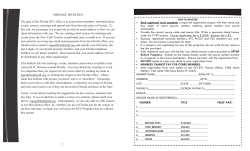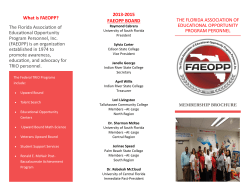
The Green Gazette April May 2015 - Collier County Extension Office
The Green Gazette Volume 6 Issue 2 Inside this Issue 2 Planting with Purpose: Wild Petunia 3 Stepping 4 The Frugal Gardener 6 Now Playing in SWFL Gardens In Our Nature Events Calendar and Announcements Dancing in the Streets for a Healthy Well-Being April - May 2015 The change in our SW Florida season is palpable, with less roadway traffic as part-time residents depart for summer destinations. Yet with rising temperatures, rainfall and tides, another season is itching to begin: mosquito season. Florida is home to 80 mosquito species, more than any other state, although only 44 are found in Collier County. Several species are considered pests, since their female adults can bite once or more, seeking blood to nourish developing eggs. But at least nine freshwater mosquito species are increasing public health concerns. These species are capable of transmitting diseases, like Chikungunya and Dengue to humans, West Nile Virus to humans and horses, Saint Louis Encephalitis (SLE) to humans and birds, Eastern Equine Encephalitis to humans, horses and birds, Dog Heartworm to dogs and cats, and Highlands J Virus mostly to birds. Fortunately, the Collier Mosquito Control District (CMCD) has been using Integrated Pest Management (IPM) methods to protect the health and welfare of Collier County residents for the past 65 years. Inspectors conduct daily surveillance over Collier’s 401 square miles during mosquito season, collecting larval samples and adult mosquito traps, data from rain gauges, and performing landing rate counts and site inspections in order to make operational treatment decisions. These methods include control of adult mosquitos as Click on CMCD’s helicopter to well as control of juvenile or larval mosquitos. view their IPM operations Continued on page 2 Gulf Currents By Mary Jane Cary, Master Gardener and Green Gazette Editor SW Florida News from the Master Gardeners It seems that UF / IFAS Extension and Southwest Florida are already celebrating the 45th anniversary of Earth Day. The month began with Ciclovia Immokalee organizers agreeing to continue these monthly outdoor family-friendly fun celebrations through the summer. Next, UF/IFAS FLREC Palm Fertilizer expert Dr. Tim Broschat announced his latest recommendations for palm fertilizers that will enable us to keep our palms, soils and water quality healthy. As we bid farewell to snowbirds as they migrate northward, we welcome new feathered friends arriving from the Caribbean and South America, just in time for spring nesting. Maternity season is well underway, from horseshoe crabs and shore birds at the beach to the Extension’s Master Gardener and FYN Coordinator Isabel Way-Soto! So we invite you all to celebrate Earth Day every day with our new Hiking In Our Nature guide and UF/IFAS solutions for your life. The Green Gazette Continued from Page 1 Ongoing research to improve surveillance and treatment is key to protecting public health. While several Florida counties are considering release of genetically modified (GM) mosquitos to prevent Dengue, the CMCD is taking a wait and see approach. Meanwhile, UF/IFAS scientists are collaborating with Australian colleagues on a new non-GM genetic control approach to combat public health threats like Dengue and Chikungunya in both locales. While the CMCD uses all the area wide approaches available to prevent mosquitoes and the diseases they transmit, the ultimate re- Click the image above to sponsibility for protecting our health rests with view CMCD’s video interview on GM mosquito use us. How? Follow these eight steps: Maintain swimming pool chemistry. Stock water gardens and ornamental ponds with native fish to reduce mosquito populations. Cover, screen or stock rain storage containers too; Discard old tires, drums, bottles, pots, and items that aren’t being used; Repair torn screening, leaky faucets, and clean gutters, garbage cans, pool covers and toys to avoid standing water; Cover boats and outdoors equipment with covers so rain will drain; Empty and clean pet water bowls and bird baths, and flush bromeliad plants, twice weekly. Empty plastic swimming pools after use; Report sitings of dead wild birds to the Florida Wildlife Research Lab; and Learn about effective mosquito control devices and services. Click the image above for biological mosquito control tips for water gardens Planting with Purpose By Mary Jane Cary, Master Gardener Shall we tempt fate by planting petunias when eastern cottontail rabbits live nearby? As it turns out, this native Wild Petunia Ruellia caroliniensis is rarely on the menu of rabbits or deer! Even better, this wildflower is the host plant for the larval caterpillars of the Common Buckeye Junonia coenia and White Peacock Anartia jatrophae butterflies. The Wild Petunia has light green leaves, and enjoys part sun locations in zones 8 - 11. With a mature height of 6” - 1 foot, and 1-2’ spread, UF article FPS514 Wild Petunia suggests uses as a ground cover or mass planting. Showy blue or violet flowers begin in spring and continue until fall, providing appealing nectar for pollinators. Invasive Mexican Petunia Ruellia tweediana This wildflower is an excellent replacement for the invasive exotic Mexican Petunia Ruellia tweediana. For more information about this invasive, click on the photo at right, and request UF article ENH1237 Managing Mexican Petunia in the Landscape. Page 2 The Green Gazette Stepping Off the Beaten Path By Master Gardener Mary Jane Cary According to NatureServe research, areas with the highest human populations also host the greatest plant diversity. So it is no surprise that Florida, now the third most populous state, also ranks third in greatest plant and wildlife diversity. This diversity grows as one travels south in our peninsular state, as shown by the historical Florida plant communities map at left. Originally developed in 1967 by UF botanist John Davis, and subsequently modified by the Florida Association of Native Nurseries (FANN), this map identifies seventeen different ecosystems in Florida. So which county can claim the greatest diversity of plants and wildlife? Look closely and you’ll find two southern counties, tied with thirteen each of the seventeen habitats: Broward and its western neighbor, Collier. But with Broward County now one of Florida’s most heavily urbanized areas, is it possible that Collier County still claims its thirteen ecosystems? One great way to find out is to step off the beaten path. Year-round opportunities to explore our natural surroundings abound, from our backyards to local Conservation Collier lands, county and state parks, and national wildlife refuges. Two years ago, we began publication of our Year In Our Nature Calendar to identify the many distinctive yet subtle seasonal changes that occur in our Southwest Florida natural Click on the image above to environment, including arrivals, behaviors, and departures of the wildlife neighbors. Now, we’re debuting a companion view a larger map Hiking In Our Nature guide, to assist you in locating the many trails which offer year-round exploration. Outdoor hiking on varying terrain from grassy paths to wooden boardwalks and paved walkways provides activity levels suitable for everyone. While some trails offer signage identifying plants and habitat features, many trails offer geo-caching and other gaming opportunities using GPS-enabled devices. Following these tips will ensure your safety and maximize your enjoyment: Become familiar with the area and how to read trail maps and guides. Notify family of your plans, and take a compass, smartphone or GPS device, particularly if hiking unmarked trails or remote territory. Check the weather, particularly temperature, wind and rain forecasts, plus possible changes in tidal or fresh water bodies you may encounter. Be Trail markers identify ready to alter plans or seek shelter if you encounter a thunderstorm dur- plants at Barefoot Beach ing your trip. Wear appropriate gear, including supportive footwear, a brimmed hat, and sunglasses, and carry sunscreen, insect repellant, water and snacks. A small first-aid kit and trash collection bag are also recommended, particularly for longer trips or those into more remote areas. “Leave No Trace.” Remain on designated trails to avoid hazards like thorny plants, and to prevent disturbing sensitive habitat. Use binoculars, cameras, and sketch books to observe and record memories. Carry all trash until you can dispose of it properly. For additional hiking and viewing tips, see UF’s Outdoor Hiking and Florida Fish and Wildlife Conservation’s (FWC) Wildlife Viewing recommendations. Then gather family and friends and head out for a wonder-filled walk in our nature! Page 3 The Green Gazette The Frugal Gardener By Leah Ray, Master Gardener Compost Happens This is a composter for people who do NOT turn their compost. Just layer it properly, keep it moist and wait. Store and Protect your tools The trick is to have a Three Ring Compost Circus going with varying degrees of compost. See how in UF’s Compost Happens tutorial. Bonus: This container can also be used to grow potatoes. Store tools in Builder’s Sand to reduce rust build up. See this UF / IFAS article Garden Tool Care for more tips. Pull up a Bucket Purchase or make your own handydandy bucket with tool carrier. Use the center bucket for hauling things or even sitting on. Plant Ring S ave pl ant tags on a key ring for easy reference. Garden Cuttings Don’t ruin one of your good kitchen knives. Purchase inexpensive ones at dollar stores. See UF’s Gardening in a Minute site for more uses of Garden Knives. Rake ‘em up! Got an old rake that is no longer in use? Repurpose it by making a charming tool hook out of it. Page 4 The Green Gazette Pruning Trees for Wind-storm Readiness Courtesy of Florida Friendly Landscaping Principle # 7: Recycle By Master Gardener Stephanie Orlikoff Homeowners with properly pruned trees enjoy beautiful landscapes while reducing property damage risks from winds and summer storms. The most wind-resistant trees feature a central leader with well-spaced branches along the trunk. There are no narrow junctions, or branches leaving the trunk at acute angles, since these branches are more likely to tear under wind stress. Junctions with 45 - 90° angles are less likely to split than narrower V-crotches of 40° or less. Avoid trimming young trees to make them bushy. Instead, according to UF/IFAS article ENH64 How to Minimize Wind Damage in South Florida Landscapes, young trees should be pruned to stimulate a durable Pruning methods differ based on central leader and growth of species, size, and stage of life. well-spaced lateral branches. Click on the image to learn more. Structural pruning favors this central leader by suppressing competing leaders with reduction cuts. These cuts shorten stems back to lateral branches that are at least one-third the diameter of the cut stems. Reduction cuts also strive to prevent all branches on the tree from growing larger than half the trunk diameter. For tree species that become large at maturity, other pruning methods are needed to promote longevity, decrease future maintenance costs, and reduce risks to property and people. Crown thinning removes specific branches to reduce weight and wind resistance, enabling greater airflow through a tree’s canopy. Thinning allows sunlight to penetrate the canopy interior. As a result, main branch diameters near the trunk increase, making these branches stronger. More air passes through the canopy instead of pushing against it, so thinned trees move less, and experience less damage during windstorms. Proper thinning also results in an even distribution of branches along individual limbs, instead of branch clusters toward the ends, like lion tails. The Nine Florida Friendly Landscaping™ (FFL) Principles 1. Right Plant, Right Place 2. Water Efficiently 3. Fertilize Appropriately 4. Mulch 5. Attract Wildlife 6. 7. Recycle 8. Reduce Storm Water Runoff 9. Protect the Waterfront View UF’s narrated slideshow of The Nine FFL Principles Crown reduction removes or shortens longer limbs, thus decreasing the overall size of the canopy. This practice also reduces canopy weight and wind resistance. Although crown reduction modifies tree canopy size to some degree, it is no substitute for “Right Plant, Right Place” tree selection! Crown reduction is best accomplished by cutting limbs back to their point of origin, or back to a lateral branch capable of sustaining the remaining limb and assuming a dominant role. When selecting qualified professionals to prune your trees and palms, follow the tips in UF/IFAS article FOR116 Get the Right Tree Professional. Then head to the International Society of Arboriculture (ISA) website to find a certified local arborist to care for your landscape’s most visible assets. Page 5 The Green Gazette Now Playing in SWFL Gardens By Leah Ray, Master Gardener We’ve had a few showers and some moderate temperatures, but hot and dry weather is bound to happen long before the rains begin. Train your turf and plantings now to grow deep roots by irrigating only when they’re thirsty, and you’ll be rewarded with a healthy landscape fit for year-round enjoyment. Color and Shade: Want to be the envy of your neighborhood? Click on the Pink Shower Tree photo at left to see more SWFL beautiful flowering trees. Simple steps to beautiful: Hot, dry weather is tough on our landscapes, particularly the turf. But by following these four simple landscape practices and this fertilization guidance, your landscape and our environment will be more beautiful and sustainable with less time, money and effort required. Irrigate wisely: April is Water Conservation Month, and you can reduce your water bills and improve your landscape’s performance by placing a rain gauge in your landscape, setting your irrigation timers on “manual,” and irrigating when your landscape becomes thirsty. Perform regular irrigation system maintenance now, then be sure to follow the current Collier County irrigation guidelines. Pruning: Royal palms and foxtail palms are self-pruning. But for all others, use these proper palm pruning practices, and you’ll have a beautiful and windresistant landscape. Click on the photo at right to view a brief video showing proper techniques. And when you see inept commercial operators over-pruning palms? Take photos of the offenders and damage, and call Collier County Code Enforcement at 239-252-2440 to report them. In Our Nature By Master Gardener and Master Naturalist Bette Nebel School is in session, as many local wildlife parents are busy teaching their young about good foods to eat, and where to find them. Longer days of sunshine mean more opportunities to observe our natural neighbors at work and play. For more sights, see our Year In Our Nature Calendar. Over 450 million years ago, there were Horseshoe Crabs. Of the four species still found worldwide, only one species, Limulus polyphemus, is found in North America along the Atlantic and Gulf coasts from Maine to Mexico. These creatures are more closely related to arachnids, like spiders and scorpions, than crustaceans, like crabs, lobsters and shrimp. But they are completely harmless: they use their long spike-like tail to flip themselves over if they are accidentally overturned. Horseshoe crabs aerate the sea floor as they feed, coming ashore to spawn between March and November. Although nesting in Florida can occur virtually year-round, peak spawning occurs from April through August when the moon is in full or new moon phases. This is good news, since horseshoe crab eggs are a food source for fish, and over half the diet of 11 species of nesting shorebirds. You can help by reporting horseshoe crab nesting locations to wildlife biologists. Count yourself lucky if your landscape is home to Florida’s only native lizard, the Green Anole Anolis carolinensis. Although not a chameleon, they can turn their totally green form entirely brown. As a result, they are frequently mistaken for the more common but non-native Brown Anole Anolis sagrei. From spring to fall, anoles lay eggs every two weeks among the leaf litter. Anoles live for about a year, dining on mosquitos, flies, beetles and spiders, and frequently fleeing capture by leaving their “disposable tail” behind. Page 6 The Green Gazette National Safe Digging Month Buried utilities are often out of sight and out of mind. But digging into one can be costly and dangerous. That’s why you must always call 811 before you dig. Sunshine 811 is a free public service that coordinates the "Call 811 before you dig" process between excavators and member utilities in Florida. We notify member utility companies when you are planning to dig, and they mark the approximate location of underground lines, pipes and cables in your yard or construction site. The process takes two full business days. Day 1 starts the day after you call. Learn how you can keep your family and neighborhood safe by clicking on the image at right. There’s still time (until April 14th) to share your thoughts with the Florida Wildlife Commission concerning Florida Black Bear management. Go to http:// www.myfwc.com/wildlifehabitats/managed/bear/. In addition, Collier County Commissioners want your ideas about restarting the roadway landscaping program. View the hyperlinked article, then click on the photo at right to email your ideas and opinions to all of the Commissioners. SWFL Gulf & Garden Calendar See Collier Extension Calendar for more details. http://ufifascollierextension.eventbrite.com April Apr Apr 9 April SFL Garden Calendar Are You Smarter Than A Stone Crab, SeaGrant Agent Bryan Fluech, Tour starts at Marco Island Library. 3:30 - 6:30 pm. $ 17/person. Register online or email Bryan Fluech. Apr 11 Everglades River of Grass, Ray Judah, Volunteer at these sites, 8-11 am. Email litternot@earthlink.net. Apr 13 Florida Friendly Landscaping For Associations Workshop, Collier Extension, 1 - 3:30 pm. Free. Register at eventbrite, or email Isabel Way-Soto. Apr 15 Tree Pruning 101, Lee County Extension Agent Stephen Brown, North Fort Myers Recreation Center, 2000 North Recreation Park Way, North Fort Myers, 10am - 2:45pm. $ 18/person online, $ 25/person at the door. Register at Eventbrite, or email Stephen Brown. Apr 18 Managing Collier’s Mosquitos, Information booth with Collier Mosquito Control District Public Information Officer Adrian Salinas, adjacent to Master Gardener Walk-in Plant Clinic, Home Depot, 1651 Airport-Pulling Rd S., 10am - Noon. Free. May May May SFL Garden Calendar May 1 Florida Friendly Landscaping For Associations Workshop, Collier Extension, 1 - 3:30 pm. Free. Register at eventbrite, or email Isabel Way-Soto. June June June SFL Garden Calendar Next Green Gazette Jun 10 Green Industries Best Management Practices more in next Green Gazette Page 7 The Green Gazette Dancing in the Streets for Healthy Well-Being By Family Nutrition Program Agent Suzanne Fundingsland and Master Gardener Mary Jane Cary There was dancing in the streets of Immokalee on Saturday, April 4th, as Ciclovia Immokalee organizers announced that these monthly events will continue through the summer. The car-free celebrations, held on the first Saturday of each month, enable families, friends and neighbors to walk, run, bike, dance and enjoy healthy foods and outdoor activities together. Click on the photo at right to view the latest Ciclovia Immokalee celebrations. Black Bean Cakes Serves 4 - 6 2 15 oz. cans low-sodium Black Beans, drained and rinsed 2 large tomatoes, seeded and chopped 1/4 cup bell pepper, chopped 1/4 cup fresh cilantro, chopped 1/4 cup fresh sweet corn kernels 1/2 cup green onion, diced 1 large clove garlic, minced 2 tsp ground cumin 1 tsp chili powder 1 cup all-purpose unbleached flour 4 Tbsp. Olive oil Combine all ingredients except flour and olive oil in a medium-sized mixing bowl, mixing well. Separate 1/3 of mixture into smaller mixing bowl, mashing the contents, then return to larger bowl. Slowly add flour 1 Tbsp. at a time, until mixture is thick enough to form into a ball. Heat 4 Tbsp. olive oil in large sauté pan over medium-high heat. Form golf-ball-size patties, and place in pan. Lightly flatten cakes with spatula, and sauté until golden brown on both sides. Drain cakes on paper towel. Serve with Fresh Spinach and Spicy Yogurt Sauce Combine these ingredients in a small bowl, and mix well: 2 cups plain, non-fat Greek Yogurt, juice from 1 lime, 1/4 cup fresh chopped cilantro, 1 Tbsp. dried cumin, 1 tsp. chili powder, plus kosher salt and freshly ground pepper to taste. Keep chilled. Just before serving, rinse 2-3 cups fresh spinach, pat dry, and spread onto serving plates. Place warm bean cakes on spinach, and serve with chilled spicy yogurt sauce. Add a Florida Fresh Tomato Salad as a side, and you have a quick and easy meal and cleanup. And what better way to finish off your meal than with a Florida Berry Snack Bar, featuring local fresh strawberries and blueberries. Visit a Master Gardener Plant Clinic Today! Call 239 252 4815 or email CollierMG@ifas.ufl.edu anytime “Bring us your tired, your poor, your pest-infested plants, yearning to be healed…” Mondays, Wednesdays and Fridays 9 am — Noon and 1 — 4 pm Collier Extension 14700 Immokalee Rd. Tuesdays through April 28 Browse our library of Green Gazette issues at http://collier.ifas.ufl.edu/ HomeGarden/Newsletters.shtml Thursdays FREE OFFER! Saturdays 10 am — Noon Home Depot 1651 Airport-Pulling Rd S. Saturdays through April 25 1 - 3 pm Lowe's 12730 Tamiami Trail East Subscribe to the Green Gazette by emailing us at CollierMG@ifas.ufl.edu Page 8
© Copyright 2025










